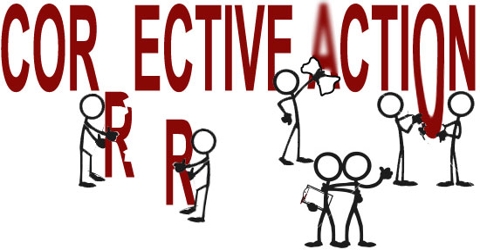Taking Corrective Action:
Corrective action is a process of communicating with the employee to improve attendance, unacceptable behavior or performance. No corrective action is required when the deviations are within acceptable limits. However, when the deviations go beyond the acceptable range, especially in the important areas, it demands immediate managerial attention so that deviations do not occur again and standards are accomplished.
Corrective action might involve training of employees if the production target could not be met. Similarly, if an important project is running behind schedule, corrective action might involve assigning additional workers and equipment to the project and permission for overtime work.
- Corrective action is a process of communicating with the employee to improve attendance, unacceptable behavior, or performance.
- Taking corrective action requires identifying the problem and implementing a potential solution.
- In any business, at some point employers such as HR managers, managers, or small business owners have to take corrective actions and/or discipline employees.
The basic control process includes the following steps:
1. Establishment of Standards:
Managers must translate plans into performance standards. Standards like employee morale, discipline, public relations, the image of the concern, etc. cannot be easily quantified, as they are intangible. These performance standards can be in the form of goals, such as revenue from sales over a period of time. A standard should be tangible, for better evaluation. Performance standards are expressed in terms of cost, quality, quantity, and time.
2. Measurement of Actual Performance:
If performance is not measured, it cannot be ascertained whether standards have been met. Work, operations, and turnout should be observed, measured and facts collected. Statistical data, reports, opinions, accounting information, etc. will help in measuring the actual performance.
3. Comparison of Actual Performance with the Original Standards:
Accept or reject the product or outcome. The comparison may disclose either agreements or deviations from the standards established. But the manager has to be very clear about the concept of deviation: minor or negligible deviations may be ignored, but major and significant deviations should be correctly understood.
4. Taking Corrective Action:
Managers must determine why standards were not met. Corrective action should be taken immediately, without any loss of time. Corrective action may be improving the techniques, organizational structure, proper selection, training, and remuneration of workers. This step also involves determining whether more control is necessary or if the standard should be changed.
5. Feedback:
If the feedback is positive and reveals accomplishment, the manager must encourage and appreciate the subordinates. If the feedback brings negative results, the manager has to take corrective action and alter the operations accordingly. Feedback will help in getting information well in time about work performance, and it also motivates people.















